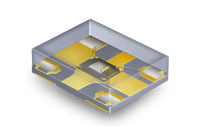Jun 26 2008
Ecliptek has just shortened the delivery time on their complete product line of EMO oscillators. Ecliptek's programmable MEMS clock oscillators provide component engineers with a vast range of readily available solutions, necessary to meet the dynamic requirements of today's global market.
 EMO MEMS Programmable Clock Oscillator
EMO MEMS Programmable Clock Oscillator
"Reduction of lead times is always a positive," said Robert Zarrow, Vice President of Sales. "With improved processes, Ecliptek has been able to cut volume deliveries dramatically, in many cases half of what they were previously."
Available package sizes include 5mm x 7mm, 3.2mm x 5mm, 2.5mm x 3.2mm, and 2.0mm x 2.5mm in supply voltage of 3.3V, 2.5V, or 1.8V. Ecliptek currently processes production quantities up to 10,000 units within 8 working days at pricing below the longer lead time fixed frequency oscillator products.
The EMO family is an oscillator product where the CMOS output frequency is primarily controlled by an internal MEMS (micro-electro-mechanical system) resonator. At the heart of EMO oscillators is a vibrating MEMS mechanical resonator 100 times smaller than its consumer grade quartz competitor which allows ultra-miniature packaging without sacrificing performance.
"In lieu of waiting up to 5 weeks for samples of quartz based oscillators, and then another 8 weeks for production delivery, Ecliptek can ship free samples within 1 - 2 days and production quantities (from 100 to 10,000 units) in 3 to 8 days, with reduced costs," said Zarrow.
The EMO oscillators use QFN-type plastic injection molded packaging, resulting in outstanding thermal performance, high reliability and minimal lead inductance. In comparison, quartz crystal oscillators require more expensive, special purpose ceramic or metal packages.
The Engineering community is tasked with specifying smaller components while actively reducing cost and lead time. Ecliptek's EMO product provides all of these advantages to designers, along with improved performance and reliability, paving the way for future generations of programmable MEMS clock oscillators.